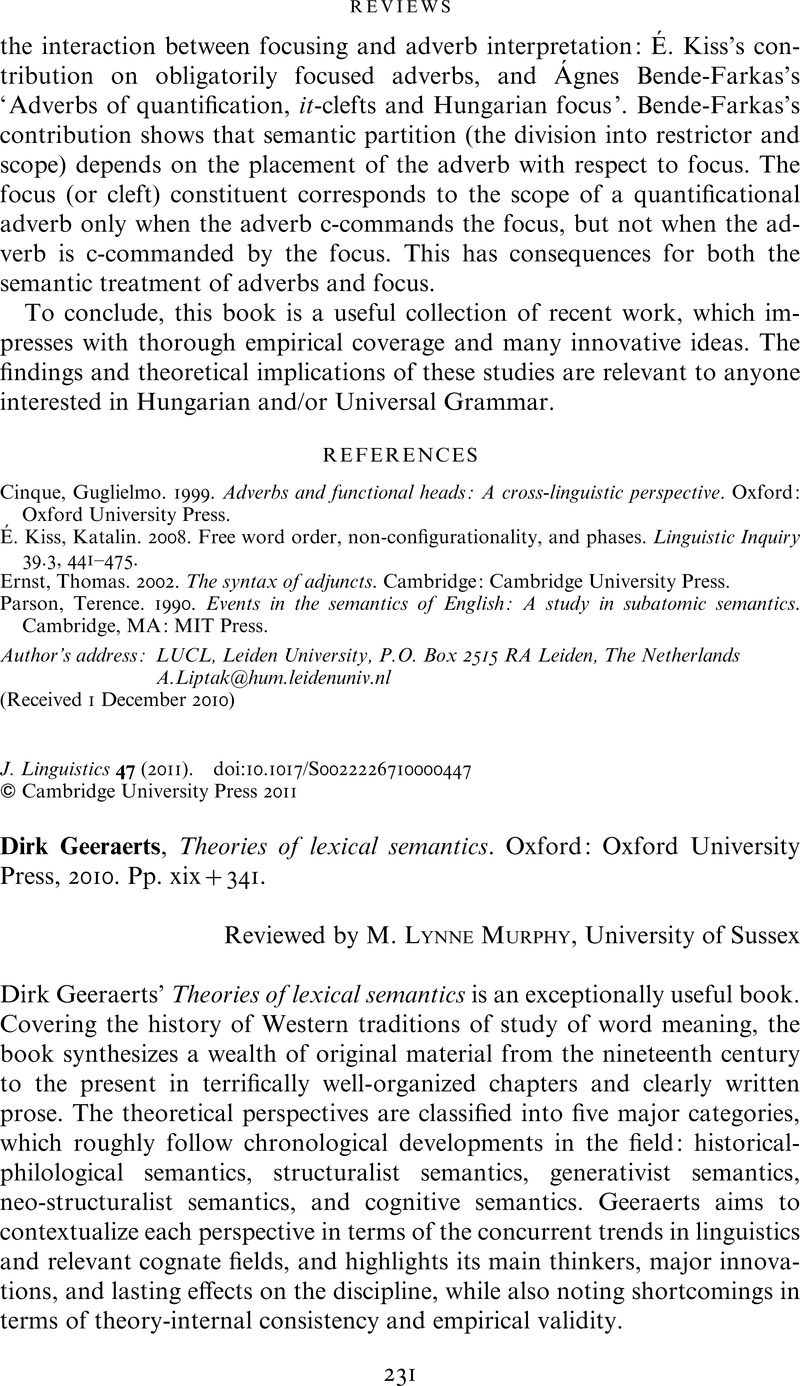No CrossRef data available.
Article contents
Dirk Geeraerts, Theories of lexical semantics. Oxford: Oxford University Press, 2010. Pp. xix+341.
Review products
Dirk Geeraerts, Theories of lexical semantics. Oxford: Oxford University Press, 2010. Pp. xix+341.
Published online by Cambridge University Press: 09 February 2011
Abstract
An abstract is not available for this content so a preview has been provided. Please use the Get access link above for information on how to access this content.

- Type
- Reviews
- Information
- Copyright
- Copyright © Cambridge University Press 2011
References
REFERENCES
Bierwisch, Manfred. 1983. Semantische und konzeptuelle Repräsentation lexikalischer Einheiten. In Motsch, Wolfgang & Ruzicka, Rudolf (eds.), Untersuchungen zur Semantik, 61–99. Berlin: Akademie Verlag.Google Scholar
Bierwisch, Manfred. 1989. The semantics of gradation. In Bierwisch, Manfred & Lang, Ewald (eds.), Dimensional adjectives, 71–261. Berlin: Springer.CrossRefGoogle Scholar
Bréal, Michel. 1897. Essai de sémantique: science des significations. Paris: Hachette.Google Scholar
Carnoy, Albert. 1927. La science des mots: traité de sémantique. Leuven: Editions Universitas.Google Scholar
Fellbaum, Christiane (ed.). 1998. WordNet: An electronic lexical database. Cambridge, MA: MIT Press.CrossRefGoogle Scholar
Goddard, Cliff. 1998. Semantic analysis: A practical introduction. Oxford: Oxford University Press.Google Scholar
Mel'čuk, Igor A. 1970. Towards a functioning model of language. In Bierwisch, Manfred & Heidolph, Karl Erich (eds.), Progress in linguistics, 198–207. The Hague: Mouton.Google Scholar
Mel'čuk, Igor A., Clas, André & Polguère, Alain. 1995. Introduction ´ la lexicologie explicative et combinatoire. Paris & Louvain-la-Neuve: Duculot.Google Scholar
Stern, Gustaf. 1931. Meaning and change of meaning, with special reference to the English language. Gothenberg: Elanders Boktryckeri Aktiebolag.Google Scholar
Trier, Jost. 1931. Der deutsche Wortschatz im Sinnbezirk des Verstandes: Die Geschichte eines sprachlichen Feldes I. Von den Anfängen bis zum Beginn des 13. Jhdts. Heidelberg: Winter.Google Scholar
Weisgerber, Leo. 1927. Die Bedeutungslehre: Ein Irrweg der Sprachwissenschaft? Germanisch-Romanische Monatsschrift 15, 161–183.Google Scholar
Wierzbicka, Anna. 1972. Semantic primitives. Translated by Anna Wierzbicka and John Besemeres. Frankfurt am Main: Athenäum.Google Scholar
Wierzbicka, Anna. 1996. Semantics: Primes and universals. Oxford: Oxford University Press.CrossRefGoogle Scholar


